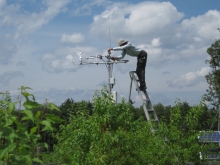You are here
Carbon and Water Dynamics in a Deciduous Clearcut

A new Harvard Forest study released today in Global Change Biology provides the first detailed account of how carbon, water, and energy balances shift in the years following a clearcut of a broadleaf temperate forest.
Results show a steady loss of carbon dioxide to the atmosphere from the clearcut area, primarily from exposed soils and decaying wood. The cleared area will only become a significant "sink" for atmospheric carbon after a decade or more of regrowth.
But in the short term, the study showed that rapid growth of native plants helped recover the rate of ecosystem water use, leading to a surprisingly modest, short-lived increase in the amount of rainwater running off to lakes, streams, and rivers.
Overall, the study--led by Christopher Williams of Clark University with students from the Harvard Forest Summer Research Program--demonstrates the ability of a forest to recover from a severe disruption, provided the land is not converted to other, non-forested uses. The study was funded by multiple sources: Clark University, NASA, the National Science Foundation, and the Long-Term Ecological Research Program.

